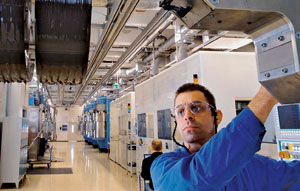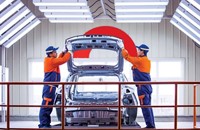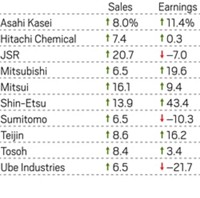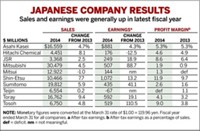Advertisement
Grab your lab coat. Let's get started
Welcome!
Welcome!
Create an account below to get 6 C&EN articles per month, receive newsletters and more - all free.
It seems this is your first time logging in online. Please enter the following information to continue.
As an ACS member you automatically get access to this site. All we need is few more details to create your reading experience.
Not you? Sign in with a different account.
Not you? Sign in with a different account.
ERROR 1
ERROR 1
ERROR 2
ERROR 2
ERROR 2
ERROR 2
ERROR 2
Password and Confirm password must match.
If you have an ACS member number, please enter it here so we can link this account to your membership. (optional)
ERROR 2
ACS values your privacy. By submitting your information, you are gaining access to C&EN and subscribing to our weekly newsletter. We use the information you provide to make your reading experience better, and we will never sell your data to third party members.
Business
A Debut With Elan
Wacker makes a splash with its first annual results after its launch on the stock exchange
by Patricia L. Short
April 2, 2007
| A version of this story appeared in
Volume 85, Issue 14

Peter-Alexander Wacker, president of Wacker Chemie, was in fine form for the first annual financial results following the April 2006 stock market launch of the firm his family founded almost a century ago.
He had good reason to be ebullient: The company's sales in 2006 were $4.20 billion, up 21% from 2005, and net profits were $248 million, up 117%. Excluding nonrecurring gains in 2005, the company showed a 39% gain in operating income to $987 million.
"It is nothing to stage a successful initial public offering," Wacker said at the results announcement late last month. "What is difficult is to justify our performance with investors. The 2006 results are proof we have surpassed our original goals."
Some 80% of the German company's sales were generated internationally, he pointed out, driven by strong growth in Asia and, more specifically, China. But additionally, he noted that "after years of stagnation, Germany likewise enjoyed economic growth."
Wacker cited several reasons for the upturn in sales and earnings. One, he said, was robust sales of silicon wafers to the semiconductor business, which is enjoying strong global demand from manufacturers of cell phones and MP3 players. Another reason was high capacity utilization. In dispersible polymer powders for the construction industry, for example, the company ran its plants at full capacity throughout the year, despite the seasonal nature of the industry. And productivity gains through process improvements also contributed to the growth in sales volumes.
The strong performance showed across the company's portfolio in 2006. An exception, in the fourth quarter, was the fine chemicals division, which, according to Wacker, "did not meet prior year's figures." In fact, sales in the quarter were down 17%, and operating profits fell 62%.
Wacker attributed the declines to falling prices for standard products and related restructuring charges. However, he added, the fine chemicals division accounts for only 3% of Wacker's sales and thus "has no material impact" on its performance. Moreover, for the full year, the division showed a 2% upturn in sales, although operating profits were down 40%.
Elsewhere, the company enjoyed double-digit volume growth in its polysilicon division, which makes hyperpure silicon used by the solar-power industry and as a raw material for silicon wafers for the semiconductor industry. Its Siltronic subsidiary, which turns the hyperpure silicon into silicon wafers, registered similarly robust growth.
Wacker pointed out several major projects. For example, two new plants with a combined capacity to make 8,000 metric tons per year of polycrystalline hyperpure silicon are under construction at the company's Burghausen, Germany, site; the investment is budgeted at $628 million. Siltronic is expanding production of 300-mm silicon wafers to 200,000 wafers per month, in Freiberg, Germany, and to 135,000 wafers per month in Burghausen, at a cost of $163 million.
Wacker also mentioned progress on a $1 billion joint venture with Samsung Electronics, for which Siltronic is building a production line for 300-mm wafers in Singapore. Production is scheduled to start in mid-2008, and peak monthly capacity of 300,000 wafers is expected by 2010.
The company is particularly bullish on investments at a silicones plant in Nünchritz, in eastern Germany, that it has owned for nine years. The plant was built in 1900 to produce a variety of inorganic commodities, including sulfuric acid, and began making silicones in 1954. The site had been acquired by Hüls, now part of Degussa, when the German government privatized assets of the former East German Republic after reunification in 1989. Wacker bought it from Hüls in 1998.
Following the financial results press conference, the company took a group of international journalists to visit the site, where it has invested more than $625 million to create one of its most modern silicone manufacturing locations.
The Nünchritz site now uses silicon, ethylene, methanol, and methyl chloride as the raw materials that it converts into a broad range of silicon chemicals: chlorosilanes for production of silicon wafers; silicates for anticorrosive coatings binders and casting molds; potassium siliconate, an impregnating agent for wood; antifoam agents; pyrogenic silica for rheology control; and silicone fluids, emulsions, polymers, and rubber.
Nünchritz's manufacturing facilities are all interlinked to form what Site Manager Gerd Kunkel described as a highly integrated production system that ensures efficient recycling and use of by-products. For example, the hydrogen chloride generated during conversion of methylchlorosilanes to siloxane is recycled into the company's chlorosilane process to produce pyrogenic silica and other organochlorosilanes.
Last November, the company's second siloxane monomer plant expansion was completed, Kunkel said. The expansion, closely following a similar project the year before, brought the site's siloxane capacity to 100,000 metric tons per year. In 2005, Wacker also expanded its silicone-cartridge-filling capacity at Nünchritz, the third such expansion in four years.
One Wacker manager says his reaction, when first arriving at the Nünchritz site, was an enthusiastic "Oh, boy!" He was excited, he recalls, because Wacker came to build, not to close down-a far too common experience for the chemical industry in eastern Germany.
Wacker now has a total of 2,000 employees at the Nünchritz site and the Siltronic silicon wafer plant in nearby Freiberg. That makes the company the largest chemical employer in the state of Saxony. As Kunkel noted, "We play a major part in the region's economy."





Join the conversation
Contact the reporter
Submit a Letter to the Editor for publication
Engage with us on Twitter